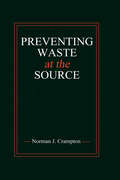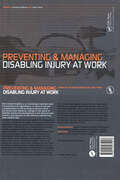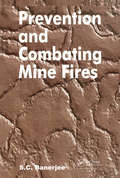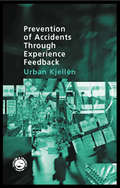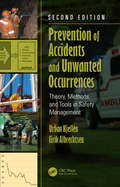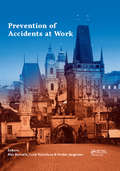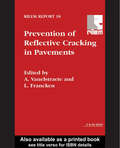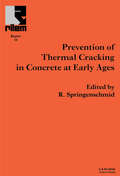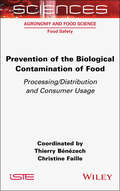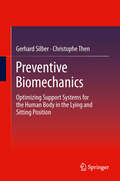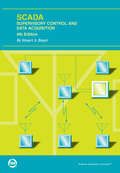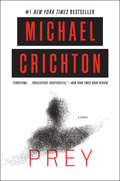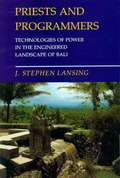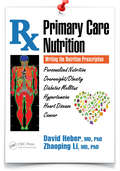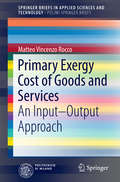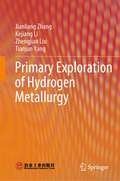- Table View
- List View
Preventing Waste at the Source
by Norman J. CramptonAfter a day's work is finished, take a look around at your company. Do standard production processes and day-to-day operations leave you with loaded trash bins from the front office to the factory floor-and every place inbetween?Such "solid waste" does far more than squander resources and imperil the environment... it's undoubtedly eating up countless dollars of your profits.Corporations throughout the nation are learning to tame solid waste, by implementing improved management of materials. Preventing Waste at the Source demonstrates how more than 50 companies have effectively reduced solid waste throughout all departments-and achieved dramatic reductions in operating costs.Beginning with a strategic framework, readers can then zero in on wasteful practices affecting all aspects of a business. Paper reduction measures for administrative offices, for instance. Ways to minimize packing materials over in the shipping department, while still protecting the product. There's also steps where suppliers and customers can take part in waste minimization efforts. Case histories prove it can be done, to everyone's advantage.Researched and compiled by the Indiana Institute on Recycling, Preventing Waste at the Source offers practical, on-the-job assistance to environmental managers, plant managers, manufacturing and quality engineers. Put its techniques and real-life guidance to work. You'll save more than money: you'll help save the environment.
Preventing Workplace Incidents in Construction: Data Mining and Analytics Applications (Spon Research)
by Imriyas KamardeenThe construction industry is vital to any national economy; it is also one of the industries most susceptible to workplace incidents. The unacceptably high rates of incidents in construction have huge socio-economic consequences for the victims, their families and friends, co-workers, employers and society at large. Construction safety researchers have introduced numerous strategies, models and tools through scientific inquiries involving primary data collection and analyses. While these efforts are commendable, there is a huge potential to create new knowledge and predictive models to improve construction safety by utilising already existing data about workplace incidents. In this new book, Imriyas Kamardeen argues that more sophisticated approaches need to be deployed to enable improved analyses of incident data sets and the extraction of more valuable insights, patterns and knowledge to prevent work injuries and illnesses. The book aims to apply data mining and analytic techniques to past workplace incident data to discover patterns that facilitate the development of innovative models and strategies, thereby improving work health, safety and well-being in construction, and curtailing the high rate of incidents. It is essential reading for researchers and professionals in construction, health and safety and anyone interested in data analytics.
Preventing and Managing Disabling Injury at Work
by John Frank Terrence SullivanThis unique reference reveals what works best in preventing workplace disability. Preventing and Managing Disabling Injury at Work examines the changing nature of the workplace and work force and includes recent information on effective early and staged multi-modal interventions in the workplace. The text also explores psychological risk perception and the essential linking of the workplace, clinician, insurer, and worker in the recovery process and in the prevention of subsequent disability events. Well-illustrated with case studies and practical examples, much of the book focuses on the common musculoskeletal disabilities and regional disorders along with other, broader applications.
Prevention and Combating Mine Fires
by Sudhish Chandra BanerjeeThere is a growing concern about fires in mines, coal mines in particular. Attempts are being made to improve mine fire combat efforts and their prevention, taking advantage of developments in the fields of science and technology. This book looks at those developments and their applications.
Prevention of Accidents Through Experience Feedback
by Urban KjellenProviding a practical introduction to the basic theories and principals of accident prevention through diagnosis and feedback control, this book presents the various methods and tools of safety, health, and environment (SHE) practice where experience feedback is employed. These include methods of accident and near accident reporting and investigati
Prevention of Accidents and Unwanted Occurrences: Theory, Methods, and Tools in Safety Management, Second Edition
by Urban Kjellen Eirik AlbrechtsenThis new edition comes after about 15 years of development in the field of safety science and practice. The book addresses the question of how to improve risk assessments, investigations, and organizational learning inside companies in order to prevent unwanted occurrences. The book helps the reader in analyzing the subject from different scientific perspectives to demonstrate how they contribute to an overall understanding. It also gives a comprehensive overview of different methods and tools for use in safety practice and helps the reader in analyzing their scope, merits, and shortcomings. The book raises a number of critical issues to be addressed in the improvement process.
Prevention of Accidents at Work: Proceedings of the 9th International Conference on the Prevention of Accidents at Work (WOS 2017), October 3-6, 2017, Prague, Czech Republic
by Ales Bernatik Lucie Kocurkova Kirsten JørgensenPrevention of Accidents at Work collects papers presented at the 9th International Conference on the Prevention of Accidents at Work (WOS 2017) held in Prague, Czech Republic, on October 3-6, 2017, organized by the VSB-Technical University of Ostrava. The conference on current issues within occupational safety is organized under the umbrella of Workingonsafety.net (WOS.net). WOS.net is an international network of decision-makers, researchers and professionals responsible for the prevention of accidents and trauma at work. The network aims to bring accident prevention experts together in order to facilitate the exchange of experience, new findings and best practices between different countries and sectors. WOS.net is supported by the European Agency for Safety and Health at Work (EU-OSHA).The overall theme is safety management complexity in a changing society, with the motto: Do we need a holistic approach? Underlying topics include: Foundations of safety science: theories, principles, methods and tools; Research to practice: achievements, lessons learned and challenges; Risk management and safety culture: case studies, best practices and further needs; Safety regulation: reasonable practicable approach; Education and training: prerequisite for safety; Complexity and safety: multidisciplinarity and inter-stakeholder views. Prevention of Accidents at Work should be valuable to researchers, policy makers, safety professionals, labor inspectors, labor administrators and other experts in the prevention of occupational accidents.
Prevention of Air Pollution: Selected Paper in 2024 9th International Conference on Advances in Energy and Environment Research (Environmental Science and Engineering)
by Qiang Wang Ahmad Hosseini-BandegharaeiThis book offers readers with analysis of the main causes and purification technology of air pollution.Air, as the primary element on which human life depends, directly impacts human living and health. However, a 2022 report from the World Health Organization indicated that "the air nearly the entire global population (99%) breathes exceeds WHO air quality limits, threatening their health". Currently, the main approaches to air pollution involve source control and the treatment of air pollutants.Analyzing the causes of air pollution is an effective method for controlling pollution from its source and preventing its spread. It is also an efficient and rapid way to identify harmful gas components and then apply targeted treatment.Currently, big data model analysis and sensor perception technology are widely used analytical techniques. Combined with chemical transport models, they can simulate and predict pollutants, achieving better causal analysis and forecasting.Additionally, air pollution purification is an important component of prevention of air pollution.Currently, the most important research direction is how to purify air pollution without causing secondary environmental contamination, in addition to physical and chemical means.This book provides engineers and researchers in the field of air pollution prevention with research findings related to this area. It aims to share specific and valuable knowledge and content to improve prevention of air pollution efforts.
Prevention of Premature Staining in New Buildings
by Phil ParnhamThe appearance of ugly staining early in a buildings life, ruins an otherwise pleasing appearance, tarnishes the image of the owners and gives rise to costly refurbishment works. In this book Phil Parnham raises a number of questions that should be considered whenever a new building is being designed or built. These are: * why has staining become so prominent; * what causes premature staining; which parts of new buildings are likely to be affected; * how can it be avoided? By using a number of highly illustrated case studies, the author answers these questions and ends by suggesting measures that should be taken by all design and construction professionals to prevent premature staining.
Prevention of Reflective Cracking in Pavements
by A.Vanelstraete and L.FranckenCrack reflection through a road structure is one of the main causes of premature pavement deterioration. This is a widespread problem in many countries and highway maintenance authorities are having to find economic means of repairing and upgrading their pavements. This book is the eagerly awaited state-of-the-art report which considers all differe
Prevention of Thermal Cracking in Concrete at Early Ages
by R. SpringenschmidAn important new report from the RILEM Technical Committee 119. This book presents models and methods to determine thermal stresses and cracking risks in concrete. The possible influences on and causes of thermal cracking of concrete are discussed and cases of practical measures for avoiding cracking are detailed.
Prevention of the Biological Contamination of Food: Processing/Distribution and Consumer Usage
by Thierry Bénézech Christine FailleThis book deals with risk management by focusing on microbiological risks. Throughout the food chain, foodstuff may be exposed to dangerous agents that can potentially affect its quality and thus the health of consumers. A good knowledge of the strategies and means of control implemented along the food chain after the primary production stage is a necessary condition and a prerequisite for any further improvement, but it is not sufficient. Indeed, in order to better prevent and therefore control these risks, it is essential to study both the phenomena of surface contamination and those relating to the elimination of this contamination by cleaning and disinfection operations in order to know the main mechanisms. Thanks to this, a certain number of innovations can already be proposed (new surfaces, new materials and cleaning and disinfection procedures, etc.) for future developments on an industrial or domestic scale.
Preventive Biomechanics
by Christophe Then Gerhard SilberHow can we optimize a bedridden patient's mattress? How can we make a passenger seat on a long distance flight or ride more comfortable? What qualities should a runner's shoes have? To objectively address such questions using engineering and scientific methods, adequate virtual human body models for use in computer simulation of loading scenarios are required. The authors have developed a novel method incorporating subject studies, magnetic resonance imaging, 3D-CAD-reconstruction, continuum mechanics, material theory and the finite element method. The focus is laid upon the mechanical in vivo-characterization of human soft tissue, which is indispensable for simulating its mechanical interaction with, for example, medical bedding or automotive and airplane seating systems. Using the examples of arbitrary body support systems, the presented approach provides visual insight into simulated internal mechanical body tissue stress and strain, with the goal of biomechanical optimization of body support systems. This book is intended for engineers, manufacturers and physicians and also provides students with guidance in solving problems related to support system optimization.
Preventive Maintenance
by J. D. Patton Jr.This third edition of a best-selling classic shows how the investment in a preventive maintenance program repays a company in longer equipment life, smoother operation, planning, and scheduling. It includes information on computerized PM systems, enhanced techniques, and insights into preventive maintenance. The latest technology has improved equipment quality, reliability and dependability by fault-tolerance, redundant components, self-adjustments, and replacement of hydraulic and mechanical components by more reliable electronic and optical operations. Many components, however, still wear out, corrode, become punctured, vibrate excessively, become overheated by friction or dirt, or can even be damaged by humans. Fortunately, modern sensors and computers for condition monitoring and detection enable equipment to "call home" to report they need PM before they fail. The preventive maintenance advantage is that you will pay less now to do planned work when production is not pushing versus very expensive emergency repairs that may be required under disruptive conditions causing production to halt and loss of revenue. Good PM saves money over a product's life cycle. The book addresses major types of maintenance; advantages and disadvantages of PM; designing a PM program; economics of PM; nondestructive testing; scheduling; metrics; data issues; and much more.
Preventive Maintenance Technology for Asphalt Pavement (Springer Tracts on Transportation and Traffic #16)
by Feng Li Jinyan Feng Youxin Li Siqi ZhouThis book provides an overview of asphalt pavement maintenance, highlighting the key asphalt pavement maintenance technologies in China. It analyzes the trend toward preventive maintenance technologies and proposes technical guidelines and implementation rules for preventive maintenance. As such it is a valuable reference resource for technicians in related industries, both in China and abroad, as well as professionals involved in road infrastructure maintenance projects in countries participating in the Belt and Road Initiative.
Preventive Methods for Coastal Protection: Towards the Use of Ocean Dynamics for Pollution Control
by Ewald Quak Tarmo SoomereThe aim of the book is to present for non-specialist researchers as well as for experts a comprehensive overview of the background, key ideas, basic methods, implementation details and a selection of solutions offered by a novel technology for the optimisation of the location of dangerous offshore activities in terms of environmental criteria, as developed in the course of the BalticWay project. The book consists of two parts. The first part introduces the basic principles of ocean modeling and depicts the long way from the generic principles to the practical modeling of oil spills and of the propagation of other adverse impacts. The second part focuses on the techniques for solving the inverse problem of the quantification of offshore areas with respect to their potential to serve as a source of environmental danger to vulnerable regions (such as spawning, nursing or also tourist areas). The chapters are written in a tutorial style; they are mostly self-contained and understandable for non-specialist researchers and students. They are carefully peer-reviewed by international experts. The goal was to produce a book that highlights all key steps, methods, models and data sets it is necessary to combine in order to produce a practically usable technology and/or decision support system for a particular sea region. Thus the book is useful not only as a description and a manual of this particular technology but also as a roadmap highlighting the complicated technical issues of ocean modeling for practical purposes. It describes the approaches taken by the authors in an understandable way and thus is useful for educational purposes, such as a course in industrially and environmentally relevant applications of ocean modeling.
Prey (Fountas & Pinnell LLI Blue)
by Michael CrichtonIn the Nevada desert, an experiment has gone horribly wrong. A cloud of nanoparticles--micro-robots--has escaped from the laboratory. This cloud is self-sustaining and self-reproducing. It is intelligent and learns from experience. For all practical purposes, it is alive.It has been programmed as a predator. It is evolving swiftly, becoming more deadly with each passing hour.Every attempt to destroy it has failed.And we are the prey.
Pricing of Ecosystem Services in Agriculture: A Basis of Crop Insurance
by Debashis Mandal Pratap Bhattacharyya Priyabrata Santra Biswajit MondalThe book deals with the pricing of ecosystem services provided by agriculture. All provisioning, regulating, supporting and cultural services are being covered in this title. Chapters in this contributed volume cover topics such as pricing of services from the soil, water, and nutrient management. Quantified monetary values of carbon sequestration and renewable energy applications in agriculture are covered with clear-cut methodologies. This book also links ecosystem service-based pricing with crop insurance. Improving the farmers’ livelihood is the central goal of the agricultural production system throughout the world. Under the climate change context, farms’ produce is now climate-vulnerable and heavily dependent on weather conditions. Moreover, we often neglect the contribution of several positive impacts of agricultural practices on ecosystems and natural resources. Therefore, there is a need to quantify and value these ecosystem services in agriculture. However, valuation and pricing the services in agriculture both tangible and intangible is a challenge. It is necessary to have clear-cut methodologies for pricing ecosystem services of agriculture in terms of net monetary benefits. The ecosystem service-based pricing could be a solid basis for calculating the insurance to farmers in case of occurrence of natural hazard and associated crop damage. This book is of interest to scholars, teachers, researchers, environmental scientists, watershed managers, capacity builders, and policymakers. The book also serves as effective reading material for undergraduate and graduate students of agriculture economics, ecology, agronomy, and environmental sciences. National and international agricultural scientists, policymakers will also find this to be useful.
Priests and Programmers: Technologies of Power in the Engineered Landscape of Bali
by J. Stephen Lansing William C. ClarkFor the Balinese, the whole of nature is a perpetual resource: through centuries of carefully directed labor, the engineered landscape of the island's rice terraces has taken shape. According to Stephen Lansing, the need for effective cooperation in water management links thousands of farmers together in hierarchies of productive relationships that span entire watersheds. Lansing describes the network of water temples that once managed the flow of irrigation water in the name of the Goddess of the Crater Lake. Using the techniques of ecological simulation modeling as well as cultural and historical analysis, Lansing argues that the symbolic system of Balinese temple rituals is not merely a reflection of utilitarian constraints but also a basic ingredient in the organization of production.
Primary Care Nutrition: Writing the Nutrition Prescription
by David Heber Zhaoping LiThis book contains the necessary knowledge and tools to incorporate nutrition into primary care practice. As a practical matter, this effort is led by a dedicated primary care physician with the help of motivated registered dietitians, nurses, psychologists, physical therapists, and office staff whether within a known practice or by referral to the community. It is essential that the nutrition prescription provided by the physician be as efficient as possible. While many team members have superior knowledge in the areas of nutrition, exercise, and psychology, the health practitioner remains the focus of patient confidence in a therapy plan. Therefore, the endorsement of the plan rather than the implementation of the plan is the most important task of the physician. <P><P> This book proposes a significant change in attitude of primary health care providers in terms of the power of nutrition in prevention and treatment of common disease. It features detailed and referenced information on the role of nutrition in the most common conditions encountered in primary care practice. In the past, treatment focused primarily on drugs and surgery for the treatment of disease with nutrition as an afterthought. Advanced technologies and drugs are effective for the treatment of acute disease, but many of the most common diseases such as heart disease, diabetes, and cancer are not preventable with drugs and surgery. While there is mention of prevention of heart disease, this largely relates to the use of statins with some modest discussion of a healthy diet. Similarly, prevention of type 2 diabetes is the early introduction of metformin or intensive insulin therapy.
Primary Care Nutrition: Writing the Nutrition Prescription
by David Heber Zhaoping LiThis book contains the necessary knowledge and tools to incorporate nutrition into primary care practice. As a practical matter, this effort is led by a dedicated primary care physician with the help of motivated registered dietitians, nurses, psychologists, physical therapists, and office staff whether within a known practice or by referral to the community. It is essential that the nutrition prescription provided by the physician be as efficient as possible. While many team members have superior knowledge in the areas of nutrition, exercise, and psychology, the health practitioner remains the focus of patient confidence in a therapy plan. Therefore, the endorsement of the plan rather than the implementation of the plan is the most important task of the physician. This book proposes a significant change in attitude of primary health care providers in terms of the power of nutrition in prevention and treatment of common disease. It features detailed and referenced information on the role of nutrition in the most common conditions encountered in primary care practice. In the past, treatment focused primarily on drugs and surgery for the treatment of disease with nutrition as an afterthought. Advanced technologies and drugs are effective for the treatment of acute disease, but many of the most common diseases such as heart disease, diabetes, and cancer are not preventable with drugs and surgery. While there is mention of prevention of heart disease, this largely relates to the use of statins with some modest discussion of a healthy diet. Similarly, prevention of type 2 diabetes is the early introduction of metformin or intensive insulin therapy.
Primary Computing in Action
by Ben Sedman Yasemin AllsopPresenting practical ideas that support teachers and trainees with the planning, implementation and assessment of the 2014 Primary Computing Curriculum. Demonstrating how freely available apps and web-based applications, programmes for PCs and Macs, can be used creatively to design innovative and engaging activities in the Early Years, Key Stages 1 and 2. Covering all aspects of the 2014 primary curriculum, including computer science, digital literacy and information technology. Includes both plugged and unplugged activities.
Primary Computing in Action
by Ben Sedman Yasemin AllsopPresenting practical ideas that support teachers and trainees with the planning, implementation and assessment of the 2014 Primary Computing Curriculum. Demonstrating how freely available apps and web-based applications, programmes for PCs and Macs, can be used creatively to design innovative and engaging activities in the Early Years, Key Stages 1 and 2. Covering all aspects of the 2014 primary curriculum, including computer science, digital literacy and information technology. Includes both plugged and unplugged activities.
Primary Exergy Cost of Goods and Services
by Matteo Vincenzo RoccoThis book describes the Exergy-based Input Output (ExIO) framework, a comprehensive methodology for assessing the primary fossil fuels requirements for the production of goods and services within a given economy from a lifecycle perspective. In the ExIO approach, exergy is assumed to be the best suited thermodynamic metric for characterizing fossil fuels. The mathematical formulation of ExIO is based on Input-Output analysis, which defines boundaries in time and space for any system or product analyzed, encompassing its entire lifecycle. The Hybrid-ExIO approach has been developed to increase the accuracy of results and to analyze energy systems in detail, leading to the definition of criteria and indicators for identifying and optimizing the primary fossil fuels requirements of system products. Lastly, the Bioeconomic ExIO model has been proposed to account for the side effects that the working hours required for producing goods and services have on the total primary fossil fuels consumption. As such, the book will be of considerable interest to both researchers and engineers in industry, offering them essential guidelines on the utilization of exergy and thermoeconomic analysis. "
Primary Exploration of Hydrogen Metallurgy
by Jianliang Zhang Kejiang Li Zhengjian Liu Tianjun YangThis book is a monograph dedicated to hydrogen metallurgy technology in iron ore reduction in the world (mainly in China), aiming to accelerate the development of hydrogen metallurgy research and promote the low-carbon process in the iron and steel industry. This book mainly introduces the frontier theory and process technology of hydrogen metallurgy, focusing on the behavior and role of hydrogen in reducing iron ore. The specific contents include hydrogen production and storage technology, hydrogen direct reduction of iron oxide technology, hydrogen smelting reduction of iron oxide technology, plasma hydrogen reduction of iron oxide theory, and the behavior of hydrogen in blast furnace iron-making and sintering processes. This book provides a comprehensive and detailed description of the theories and process technologies involved in hydrogen metallurgy at the levels of fundamental theory, feasibility analysis, experimental studies, and industrial applications. This book can be usedas a reference for metallurgical engineering, iron, and steel metallurgy majors, as well as teachers and students, researchers, engineers, and enterprise staff interested in hydrogen and low-carbon metallurgy-related fields.
